Search results for 'DBM 502 WEEK 2 Entity Relationship Diagram and Table Definition'
-
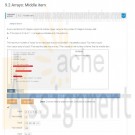
PRG 211 Week 4 Labs
Regular Price: $12.00
Special Price $9.00
PRG 211 Week 4 Labs
Lab 9.1 Output numbers in reverse
Write a program that reads a list of 10 integers, and outputs those integers in reverse. For coding simplicity, follow each output integer by a space, including the last one. Then, output a newline.
Ex: If the input is 2 4 6 8 10 12 14 16 18 20, the output is:
20 18 16 14 12 10 8 6 4 2
To achieve the above, first read the integers into an array. Then output the array in reverse.
Lab 9.2 Middle itemGiven a sorted list of integers, output the middle integer. Assume the number of integers is always odd.
Ex: If the input is 2 3 4 8 11 -1 (a negative indicates end), the output is:
4
The maximum number of inputs for any test case should not exceed 9. If exceeded, output "Too many inputs".Hint: Use an array of size 9. First read the data into an array. Then, based on the number of items, find the middle item.
Lab 9.3 Output values below an amountWrite a program that first gets a list of 5 integers from input. Then, get another value from the input, and output all integers less than or equal to that value.
Ex: If the input is 50 60 140 200 75 100, the output is:
50 60 75
For coding simplicity, follow every output value by a space, including the last one. Then, output a newline.Such functionality is common on sites like Amazon, where a user can filter results.
Learn More -
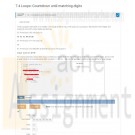
PRG 211 Week 3 Labs
Regular Price: $15.00
Special Price $12.00
PRG 211 Week 3 Labs
Lab 7.1 Loops Convert to binary
Write a program that takes in a positive integer as input, and outputs a string of 1's and 0's representing the integer in binary. For an integer x, the algorithm is:
As long as x is greater than 0
Output x % 2 (remainder is either 0 or 1)
x = x / 2
Note: The above algorithm outputs the 0's and 1's in reverse order.Ex: If the input is 6, the output is:
011
(6 in binary is 110; the algorithm outputs the bits in reverse).
Lab 7.2 Loops Varied amount of input dataStatistics are often calculated with varying amounts of input data. Write a program that takes any number of non-negative integers as input, and outputs the average and max. A negative integer ends the input and is not included in the statistics.
Ex: When the input is 15 20 0 5 -1, the output is:
10 20
You can assume that at least one non-negative integer is input.
Lab 7.3 Loops Output range with increment of 10Write a program whose input is two integers, and whose output is the first integer and subsequent increments of 10 as long as the value is less than or equal to the second integer.
Ex: If the input is -15 30, the output is:
-15 -5 5 15 25Ex: If the second integer is less than the first as in 20 5, the output is:
Second integer can't be less than the first.For coding simplicity, output a space after every integer, including the last.
Lab 7.4 Loops Countdown until matching digitsWrite a program that takes in an integer in the range 20-98 as input. The output is a countdown starting from the integer, and stopping when both output digits are identical.
Ex: If the input is 93, the output is:
93 92 91 90 89 88Ex: If the input is 77, the output is:
77Ex: If the input is not between 20 and 98 (inclusive), the output is:
Input must be 20-98For coding simplicity, follow each output number by a space, even the last one. Use a while loop. Compare the digits; do not write a large if-else for all possible same-digit numbers (11, 22, 33, ..., 88), as that approach would be cumbersome for large ranges.
Learn More -
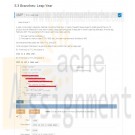
PRG 211 Week 2 Labs
Regular Price: $12.00
Special Price $9.00
Lab 5.1 Largest number
Write a program whose inputs are three integers, and whose output is the largest of the three values.
Ex: If the input is 7 15 3, the output is:
15
Lab 5.2 Remove gray from RGBSummary: Given integer values for red, green, and blue, subtract the gray from each value.
Computers represent color by combining the sub-colors red, green, and blue (rgb). Each sub-color's value can range from 0 to 255. Thus (255, 0, 0) is bright red, (130, 0, 130) is a medium purple, (0, 0, 0) is black, (255, 255, 255) is white, and (40, 40, 40) is a dark gray. (130, 50, 130) is a faded purple, due to the (50, 50, 50) gray part. (In other words, equal amounts of red, green, blue yield gray).
Given values for red, green, and blue, remove the gray part.
Ex: If the input is 130 50 130, the output is:
80 0 80
Find the smallest value, and then subtract it from all three values, thus removing the gray.Note: This page converts rgb values into colors.
Lab 5.3 Leap YearA year in the modern Gregorian Calendar consists of 365 days. In reality, the earth takes longer to rotate around the sun. To account for the difference in time, every 4 years, a leap year takes place. A leap year is when a year has 366 days: An extra day, February 29th. The requirements for a given year to be a leap year are:
1. The year must be divisible by 4
2. If the year is a century year (1700, 1800, etc.), the year must be evenly divisible by 400
Some example leap years are 1600, 1712, and 2016.Write a program that takes in a year and determines whether that year is a leap year.
Ex: If the input is 1712, the output is:
1712 is a leap year.Ex: If the input is 1913, the output is:
Learn More
1913 is not a leap year. -
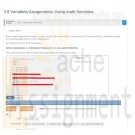
PRG 211 Week 1 Labs
Regular Price: $15.00
Special Price $12.00
Lab 3.1 Formatted Output Hello World!
Write a program the outputs 'Hello World!'
Lab 3.2 Formatted output: No parking sign.Write a program that prints a formatted "No parking" sign. Note the first line has two leading spaces.
NO PARKING
1:00 - 5:00 a.m.
Lab 3.3 House real estate summarySites like Zillow get input about house prices from a database and provide nice summaries for readers. Write a program with two inputs, current price and last month's price (both integers). Then, output a summary listing the price, the change since last month, and the estimated monthly mortgage computed as (currentPrice * 0.045) / 12.
Ex: If the input is 200000 210000, the output is:
This house is $200000. The change is $-10000 since last month.
The estimated monthly mortgage is $750.0.
Note: Getting the precise spacing, punctuation, and newlines exactly right is a key point of this assignment. Such precision is an important part of programming.
Lab 3.4 Caffeine levelsA half-life is the amount of time it takes for a substance or entity to fall to half its original value. Caffeine has a half-life of about 6 hours in humans. Given caffeine amount (in mg) as input, output the caffeine level after 6, 12, and 18 hours.
Ex: If the input is 100, the output is:
After 6 hours: 50.0 mg
After 12 hours: 25.0 mg
After 18 hours: 12.5 mg
Note: A cup of coffee has about 100 mg. A soda has about 40 mg. An "energy" drink (a misnomer) has between 100 mg and 200 mg.
Lab 3.5 Divide by x.Write a program using integers userNum and x as input, and output userNum divided by x four times.
Ex: If the input is 2000 2, the output is:
1000 500 250 125
Note: In Coral, integer division discards fractions. Ex: 6 / 4 is 1 (the 0.5 is discarded).
Lab 3.6 Driving costs.Driving is expensive. Write a program with a car's miles/gallon and gas dollars/gallon (both floats) as input, and output the gas cost for 10 miles, 50 miles, and 400 miles.
Ex: If the input is 20.0 3.1599, the output is:
1.57995 7.89975 63.198
Note: Small expression differences can yield small floating-point output differences due to computer rounding. Ex: (a + b)/3.0 is the same as a/3.0 + b/3.0 but output may differ slightly. Because our system tests programs by comparing output, please obey the following when writing your expression for this problem. First use the dollars/gallon and miles/gallon values to calculate the dollars/mile. Then use the dollars/mile value to determine the cost per 10, 50, and 400 miles.Note: Real per-mile cost would also include maintenance and depreciation.
Lab 3.7 Simple statistics.Part 1
Given 3 integers, output their average and their product, using integer arithmetic.Ex: If the input is 10 20 5, the output is:
11 1000
Note: Integer division discards the fraction. Hence the average of 10 20 5 is output as 11, not 11.666666666666666.Submit the above for grading. Your program will fail the test cases (which is expected), until you complete part 2 below but check that you are getting the correct average and product using integer division.
Part 2
Also output the average and product, using floating-point arithmetic.Ex: If the input is 10 20 5, the output is:
11 1000
11.666666666666666 1000.0
Lab 3.8 Using math functionsGiven three floating-point numbers x, y, and z, output x to the power of y, x to the power of (y to the power of z), the absolute value of x, and the square root of (xy to the power of z).
Ex: If the input is 5.0 6.5 3.2, the output is:
34938.56214843421 1.2995143401732918e+279 5.0 262.42993783925596
Hint: Coral has built-in math functions (discussed elsewhere) that may be used.
Learn More
Function Behavior Example
SquareRoot(x) Square root of x SquareRoot(9.0) evaluates to 3.0.
RaiseToPower(x, y) Raise x to power y: RaiseToPower(6.0, 2.0) evaluates to 36.0.
AbsoluteValue(x) Absolute value of x AbsoluteValue(-99.5) evaluates to 99.5. -
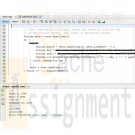
PRG/421 Week 2 Java Lab 2.22 LAB: Parsing dates
Regular Price: $6.00
Special Price $3.00
PRG/421 Week 2 Java Lab 2.22 LAB: Parsing dates
Complete main() to read dates from input, one date per line. Each date's format must be as follows: March 1, 1990. Any date not following that format is incorrect and should be ignored. Use the substring() method to parse the string and extract the date. The input ends with -1 on a line alone. Output each correct date as: 3/1/1990.
Ex: If the input is:
March 1, 1990
April 2 1995
7/15/20
December 13, 2003
-1then the output is:
Learn More
3/1/1990
12/13/2003 -
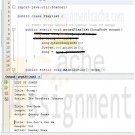
PRG/421 Week 2 Java 2.16 LAB: Playlist (output linked list)
Regular Price: $6.00
Special Price $3.00
PRG/421 Week 2 Lab 2.16 LAB: Playlist (output linked list)
Given main(), complete the SongNode class to include the printSongInfo() method. Then write the Playlist class printPlaylist() method to print all songs in the playlist. DO NOT print the dummy head node.
Ex: If the input is:
Stomp!
380
The Brothers Johnson
The Dude
337
Quincy Jones
You Don't Own Me
151
Lesley Gore
-1the output is:
LIST OF SONGS
-------------
Title: Stomp!
Length: 380
Artist: The Brothers JohnsonTitle: The Dude
Length: 337
Artist: Quincy JonesTitle: You Don't Own Me
Learn More
Length: 151
Artist: Lesley Gore -
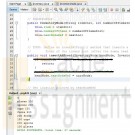
PRG/421 Week 2 Java 2.15 LAB: Inventory (linked lists: insert at the front of a list)
Regular Price: $6.00
Special Price $3.00
PRG/421 Week 2 Java 2.15 LAB: Inventory (linked lists: insert at the front of a list)
Given main() in the Inventory class, define an insertAtFront() method in the InventoryNode class that inserts items at the front of a linked list (after the dummy head node).
Ex. If the input is:
4
plates 100
spoons 200
cups 150
forks 200the output is:
Learn More
200 forks
150 cups
200 spoons
100 plates -
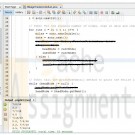
PRG/421 Week 2 Java 2.14 LAB: Mileage tracker for a runner
Regular Price: $6.00
Special Price $3.00
PRG/421 Week 2 Java 2.14 LAB: Mileage tracker for a runner
Given the MileageTrackerNode class, complete main() In the MileageTrackerLinkedList class to insert nodes into a linked list (using the insertAfter() method). The first user-input value is the number of nodes in the linked list. Use the printNodeData() method to print the entire linked list. DO NOT print the dummy head node.
Ex. If the input is
3
2.2
7/2/18
3.2
7/7/18
4.5
7/16/18the output is
Learn More
2.2, 7/2/18
3.2, 7/7/18
4.5, 7/16/18 -
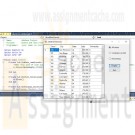
Programming with Microsoft VB 2017 Diane Zak Chapter 12 Adalene Solution
Regular Price: $7.00
Special Price $5.00
Programming with Microsoft VB 2017 Diane Zak Chapter 12 Adalene Solution
Open the Adalene Solution.sln file contained in the VB2017\Chap12\Adalene Solution folder. The application is already connected to the Adalene.mdf file, and the AdaleneDataSet has already been created. Start the application to view the records in the dataset and then stop the application. The Adalene Fashions application should allow the user to display all of the information in the dataset, only the information for company-owned stores, or only the information for franchisees. Create the appropriate queries and then use them to code the btnDisplay_Click procedure. Save the solution and then start and test the application.
Learn More -
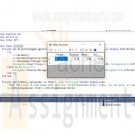
Programming with Microsoft VB 2017 Diane Zak Chapter 11 Utilities Solution
Regular Price: $7.00
Special Price $5.00
Programming with Microsoft VB 2017 Diane Zak Chapter 11 Utilities Solution
Open the Utilities Solution.sln file contained in the VB2017\Chap11\Utilities Solution-DataGrid folder.
Learn More
a. Create a SQL Server database named Utilities.mdf.
b. Add the Bills table definition shown in Figure 11-64 to the database. The Month field's (Is Identity), Identity Increment, and Identity Seed properties are set to True, 1, and 1, respectively. (Recall that you need to expand the Identity Specification property to access these properties.)
c. After defining the table, click the Update button and then click the Update Database button.
d. Open the Data Sources window and start the Data Source Configuration Wizard. Connect the Utilities.mdf file to the application. Include the entire Bills table in the dataset.
e. Set the Utilities.mdf file's Copy to Output Directory property to "Copy if newer".
f. Drag the Bills table to the form. Set the DataGridView control's AutoSizeColumnsMode property to Fill.
g. Open the DataGridView control's task list and click Dock in Parent Container. Click Edit Columns. Change the Month column's AutoSizeMode property to ColumnHeader.
h. Click Electricity in the Edit Columns dialog box, click DefaultCellStyle, click the ... (ellipsis) button, click Format, click the ... (ellipsis) button, click Numeric, and then click the OK button. The Format box now shows N2. Change the Alignment property to MiddleRight and then click the OK button to close the CellStyle Builder dialog box.
i. Now, format the Water and Gas columns using the Numeric setting with two decimal places. Also, align the values in both columns using the MiddleRight setting. When you are finished setting the properties, close the Edit Columns dialog box.
j. Change the form's Size property to 330, 200.
k. Open the Code Editor window and enter an appropriate Try...Catch statement.
l. Save the solution and then start the application. Enter the three records shown in Figure 11-64. (Recall that the Month field is an auto-numbered field. The numbers 1, 2, and 3 will appear when you click the Save Data button.)
m. Stop the application and then start it again to verify that the three records were saved.





